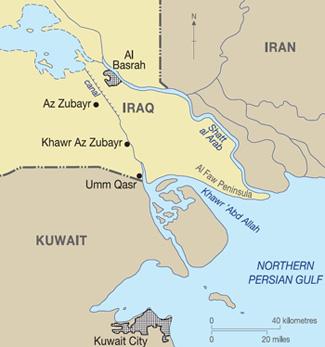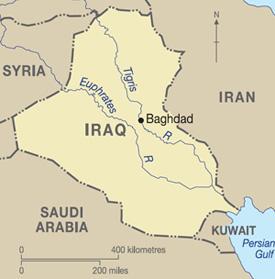Coming clean
Joy at the coming of peace, relief at the passing of danger, impatience at waiting for the voyage home to family, friends and loved ones. These are the emotional stages through which Australian sailors, soldiers and airmen pass at the end of every war. Every war, that is, except the Second Gulf War. Before returning home, the men and women of the Australian Defence Force (ADF) deployment in Iraq experienced a new emotion: frustration at the struggle to satisfy the strict cleaning requirements of the Australian Quarantine and Inspection Service (AQIS).
Australia’s military forces are subject to the nation’s laws. And so ADF personnel in the Middle East, along with their equipment and stores, had to meet the same AQIS regulations as anyone else wishing to enter Australia. The ADF did not receive any special dispensation from AQIS regarding the return of either its people or its goods. This is because, just like the military, AQIS plays a critical role in safeguarding the nation’s borders. Among its tasks is the prevention of invasion by unwanted or dangerous organisms. Endemic to the areas in which the ADF operated in the Middle East are several minute, dustborne organisms which if inadvertently brought home have the potential to devastate Australia’s grain and livestock industries. Neither the ADF nor AQIS wanted to be responsible for the release of any creature into Australia that might turn out to be another cane toad or fox. As with any invader, both agencies knew it was essential to keep these pests out.
Military personnel in the Middle East fully accepted the need to protect Australia from alien species. This was a requirement that ADF senior officers and planners had recognised even before units departed for the Middle East. However, it was only when the time came to meet AQIS’s strict guidelines that difficulties appeared. In planning for its role in the war, the ADF had paid too little attention to the postvictory period, when its forces would be readying themselves for the trip home. This unpreparedness meant that the forces in the field would have an extraordinarily difficult time in cleaning and packing vehicles and stores for the return passage.
To get home, the Australians had to go through the most rigorous and thorough cleaning regime the ADF has ever experienced. It was a heavy, manual, repetitive task, and it had to be finished quickly in order to meet the departure schedule. The result was long exhausting days, undertaken by a force already tired from the physical rigours and mental strain of war. Some cleaning episodes went on for 18 hours straight; others stretched out to as many as 48.
The ADF did its cleaning at a number of sites, depending on the unit involved. The ships of the RAN did theirs at sea, off the coast of Kuwait. The Special Forces Task Group and the sailors of Clearance Diving Team Three completed their cleaning in Kuwait City. The RAAF prepared their equipment at their air bases.
The procedures to prepare vehicles highlight the extensiveness of the cleaning regime. A vehicle had to undergo several stages of washing and inspection. First it was washed with a high-pressure hose to blast off the accumulated dust. AQIS staff then gave it a wet inspection at the wash point. If successful, the vehicle was moved to a dry stand, where it received a dry inspection. If it passed this inspection, it was wrapped in a shroud to prevent recontamination with dust. Failure at any stage resulted in another blast with the hose.
When the transport ship (either HMAS Kanimbla or Manoora) was ready for loading, the vehicle was put onto the back of a truck and driven to the harbour. It then received another inspection on shore from AQIS before an LCM8 took it out to the waiting ship. As it was driven into the cargo hold another AQIS official gave it a final blast with another high-pressure hose.
However, washing was only the final stage in a vehicle’s preparation. Prior to that, personnel had to remove and discard from the vehicle any material that could harbour dust or pests. This included all of a vehicle’s rubber, foam, and wood. This meant that vehicles lost their windows, seats, cargo trays, hoses, belts, wiring and tyres. Replacement tyres were sent out from Australia to allow for local movement and the original used tyres were discarded. A vehicle that just days before was driveable was reduced to a hollowed-out wreck that would require extensive rebuilding at home before it could return to service.


But at least vehicles could be cleaned and returned, even if in a ruined state. For some items, those made from materials that could not be cleaned to the AQIS standard, an “in-theatre” sale, donation to a local organisation, or a trip to the scrap heap were the only options. The risk of bringing these items home was too great. For example, Clearance Diving Team Three identified 117 different classes of items whose make-up was prohibitively resistant to cleaning. These included all ropes or cordage, canvas stretchers, hoses, floats, and an assortment of wooden-handled tools. Canvas was particularly vulnerable since the region’s sandstorms had forced dust deep into the fabric’s weave. As a result all tents remained in the Middle East.
Equipment made from or containing timber or wood products was of particular concern to AQIS. Wood was vulnerable to attack from boring insects that could enter Australia undetected, hidden below an article’s surface. For example, the RAN had to abandon their Zodiac boats because they had wooden frames. For the same reason, the SAS had to tear out the wooden trays from all their vehicles.
More troublesome, however, was the widespread use of wood as a packing material. Shipping containers had wooden floors, pallets were made from wood, and wooden crates were everywhere. Those preparing to depart would have to discard these seemingly ubiquitous wooden crates and repack the contents into ones made from safer materials. Once re-packed, the containers were wrapped in plastic to keep them safe from dust.
Finding sufficient numbers of replacement containers was not easy, since wood was the material of choice for pallets and crates, particularly those used to store and ship ammunition. It was the responsibility of the Joint Ammunition Logistic Organisation (JALO) to oversee the return of the force’s ammunition to Australia. Its staff scoured its facilities in Australia for all available metal containers, which they then flew to the Middle East. Its packers in Kuwait emptied wooden ammunition crates of their contents and repacked the explosives into metal.
In the end there were simply not enough metal containers available in Australia. Some items, such as RAAF replacement engines travelled home strapped down onto pallets, a less than ideal shipping method for a delicate and expensive piece of equipment. To relieve the container crisis AQIS inspectors had to make a concession. They allowed the ammunition handlers to return mortar ammunition in its original wooden packaging – with one condition, that upon arrival in Darwin JALO staff repack the ammunition into brand new boxes and burn the ones that had been to the Middle East.
Materials still in their sealed original packaging could be simply repacked into a new container in preparation for the trip home. Unfortunately, opened packages had to be inspected, and if salvageable, their contents cleaned individually by hand. This also applied to ammunition. Consequently, tens of thousands of rounds of rifle ammunition had to be laboriously handwiped to remove any traces of dust before being repacked into a new container.
The sandstorms which so adversely affected the land and air forces were also a factor for the RAN’s ships. These powerful storms reached far out into the Persian Gulf and coated the vessels in a fine red powder. The crews of HMAS Kanimbla, Anzac and Darwin (Manoora arrived later) had to wash their entire ships, paying particular attention to places were water accumulated, such as deck tie-down points. The ships also had to replace their air intake filters, which were thick with dust. A surprising discovery was that mussels had invaded the Anzac’s water intake system, clogging the pipe. Investigators found smaller infestations on Kanimbla and Darwin. The crews had to flush the pipes clean before the ships could come back to Australian waters.
The cleaning process itself resulted in additional damage. For example, none of the vehicles brought back was immediately serviceable. Land Rovers which would have required 30 hours to repair after their war use, now required 150 hours. The use of high-pressure hoses for washing also caused damage to automobile components. As a result, some vehicles needed complete engine rebuilds or the replacement of their entire electrical system.
While the Australians struggled to meet the necessarily high standard set by AQIS, they watched US forces load their equipment onto their ships after only the briefest of washes. Yet none of the ADF personnel in the Middle East, or those in headquarters at home, suggested that AQIS should relax its regime. Certainly the task was difficult. However, the consequences of releasing a dangerous organism into the Australian environment were also widely understood.
The solution for future operations is not to accept a greater pest risk, but to begin preparations for the return home even before deployment. For example, all stores should be sent overseas in non-wooden packaging, thereby lowering the ADF’s dependence on this troublesome material. There is also a need to develop less invasive cleaning procedures. And in the end, we may have to accept that it will just be impossible to bring some items home.
ADF personnel and AQIS inspectors serving in the Middle East worked towards the same goal. All were intent on protecting Australia from overseas threat. The task, borne by men and women already tired from a war, was an additional burden, but it was also an essential one. The result was the nation’s continued security.